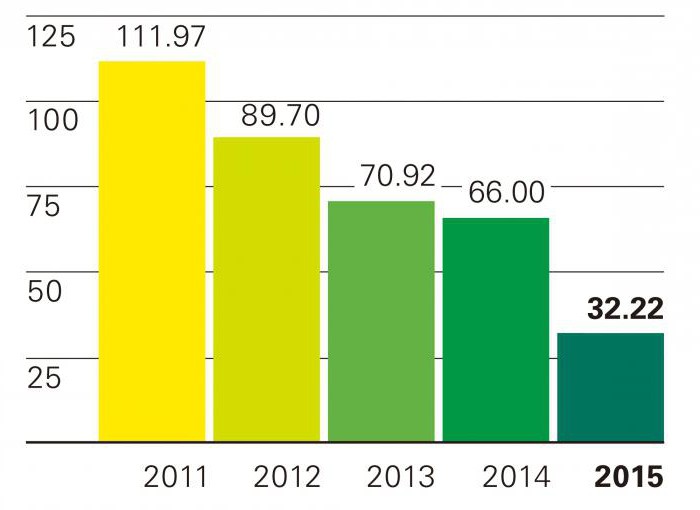Financial analysis at the enterprise is needed for an objective assessment of the economic and financial condition in the periods of past, present and predicted future activities. To determine the weaknesses of production places, the sources of problems, the detection of strong factors that management can rely on, the main financial indicators are calculated.
An objective assessment of the position of the company in terms of economy and finance is based on financial ratios, which are a manifestation of the ratio of individual accounting data. The purpose of the analysis of finance is achieved by solving a selected set of analytical tasks, that is, a concise analysis of all the primary sources of accounting, management and economic reporting.
The main objectives of economic and financial analysis
If the analysis of the main financial indicators of the enterprise is considered as revealing the true state of affairs at the enterprise, then the following answers are received as results:

- the company's ability to invest in investing in new projects;
- the current state of affairs in relation to tangible and other assets and liabilities;
- condition of loans and the ability of the company to repay them;
- the existence of reserves to prevent bankruptcy;
- identifying prospects for further financial activities;
- valuation of the enterprise in terms of value for sale or conversion;
- tracking the dynamic growth or decline of economic or financial activities;
- identification of reasons that negatively affect the results of management and the search for ways out of the situation;
- consideration and comparison of income and expenses, identification of net and total profit from sales;
- the study of the dynamics of income for major goods and in general from the entire sale;
- determination of the portion of income used to recover costs, taxes and interest;
- study the reasons for the deviation of the amount retained earnings from the amount of income from sales;
- study of profitability and reserves to increase it;
- determination of the degree of compliance of own funds, assets, liabilities of the enterprise and the amount of borrowed capital.
Stakeholders
Analysis of the main financial indicators of the company is carried out with the participation of various economic representatives of departments interested in obtaining the most reliable information about the affairs of the enterprise:

- internal entities include shareholders, managers, founders, audit or liquidation commissions;
- the external ones are represented by creditors, audit offices, investors and government officials.
Financial Analysis Capabilities
The initiators of the analysis of the enterprise are not only its representatives, but also employees of other organizations interested in determining the actual creditworthiness and the possibility of investment contribution to the development of new projects. For example, bank auditors are interested in the liquidity of a firm’s assets or its ability to pay bills at the moment. Legal entities and individuals wishing to make investments in the development fund of this enterprise are trying to understand the degree of profitability and the risks of the contribution. Evaluation of key financial indicators using a special technique predicts bankruptcy of an institution or indicates its stable development.
Internal and external financial analysis
Financial analysis is part of the overall economic analysis of the enterprise and, accordingly, part of a complete economic audit. Full analysis is divided into on-farm management and external financial audit. This division is due to two practically established systems in accounting - managerial and financial accounting. The division is recognized as conditional, since in practice the external and internal analysis complement each other with information and are logically interconnected. There are two main differences between them:
- by availability and breadth of the information field used;
- degree of application of analytical methods and procedures.
An internal analysis of the main financial indicators is carried out to obtain generalized information within the enterprise, determine the results of the last reporting period, identify available resources for reconstruction or rearmament, etc. To obtain the results, all available indicators are used, which are also applicable to research by external analysts.

External financial analysis is carried out by independent auditors, external analysts who do not have access to internal results and company indicators. External audit techniques imply a certain limitation of the information field. Regardless of the type of audit, its methods and methods are always the same. Common in the external and internal analysis is the derivation, generalization and detailed study of financial ratios. These key financial indicators of the enterprise provide answers to all questions regarding the work and prosperity of the institution.
Four key indicators of financial condition
The main requirement for the breakeven operation of the enterprise in a market economy is economic and other activities that ensure profitability and profitability. Household measures are aimed at reimbursing expenses for income received, making a profit to meet the economic and social needs of the team members and the material interests of the owner. There are many indicators for characterizing activities, in particular, they include gross income, turnover, profitability, profit, costs, taxes and other characteristics. For all types of enterprises highlighted the main financial indicators of the organization:
- financial stability;
- liquidity;
- profitability;
- business activity.
Financial stability indicator
This indicator characterizes the degree of correlation of the organization’s own funds and borrowed capital, in particular, how much borrowed funds are accounted for 1 ruble of money invested in tangible assets. If such an indicator in the calculation turns out to be more than 0.7, then the financial position of the company is unstable, the activity of the enterprise to some extent depends on the attraction of external borrowed funds.

Liquidity profile
This parameter indicates the main financial indicators of the company and characterizes the sufficiency of the current assets of the organization to repay its own short-term debts. It is calculated as the ratio of the value of current working assets to the value of current passive liabilities. The liquidity indicator indicates the possibility of converting the assets and values of the company into cash capital and shows the degree of mobility of such a transformation. The liquidity of an enterprise is determined by two perspectives:
- the period of time required to turn current assets into money;
- the ability to sell assets at a designated price.
To identify the true liquidity indicator, the enterprise takes into account the dynamics of the indicator, which allows not only to determine the financial strength of the company or its insolvency, but also to identify the critical state of the organization’s finances. Sometimes the liquidity ratio is low due to the increased demand for industry products. Such an organization is quite liquid and has a high degree of solvency, since its capital consists of cash and short-term loans. The dynamics of the main financial indicators demonstrates that the situation looks worse if the organization has working capital only in the form of a large number of stored products in the form of current assets. Their transformation into capital requires a certain amount of time for implementation and the presence of a customer base.
The main financial indicators of the company, which includes liquidity, show the state of solvency. The current assets of the company should be sufficient to repay current short-term loans. In the best position, these values are approximately at the same level. If an enterprise has working capital much more expensive than short-term loans, then this indicates an inefficient investment of money by the enterprise in current assets. If the amount of working capital is lower than the cost of short-term loans, this indicates the imminent bankruptcy of the company.

As a special case, there is an indicator of fast current liquidity. It is expressed in the ability to repay short-term liabilities due to the liquid part of assets, which is calculated as the difference between the entire current part and short-term liabilities. International standards determine the optimal level of the coefficient in the range of 0.7-0.8. The presence in the enterprise of a sufficient number of liquid assets or net working capital attracts lenders and investors to invest in the development of the enterprise.
Profitability indicator
The main financial performance indicators of the organization include the value of profitability, which determines the effectiveness of the use of funds of the owners of the company and generally shows how profitable the work of the enterprise. The value of profitability is the main criterion for determining the level of stock quotes. To calculate the indicator, the amount of net profit is divided by the amount of average profit from the sale of net assets of the company for the selected period. The indicator reveals how much net profit each unit of goods sold has brought.
The generated income ratio is used to compare the income of the desired company, compared with the same indicator of another company operating under a different taxation system. Calculation of the main financial indicators of this group provides for the ratio of profit before taxes and interest due to the assets of the enterprise. As a result, information appears on how much profit each monetary unit invested in the company’s assets brought.
Business activity
It characterizes how much finance is obtained from the sale of each monetary unit of a certain type of asset and shows the rate of turnover of the financial and material resources of the organization. For the calculation, the ratio of net profit for the selected period to the average cost of costs in material terms, money and short-term securities is taken.

There is no normative limit for this indicator, but the managerial forces of the company strive to accelerate turnover. The constant use of external loans in economic activity indicates the insufficient receipt of finances as a result of sales, which do not cover production costs.If the amount of assets being circulated on the organization’s balance sheet is overstated, this results in payment of additional taxes and interest on bank loans, which leads to loss of profit. A low number of active funds leads to delays in the implementation of the production plan and the loss of profitable commercial projects.
For an objective visual review of indicators of economic activity, special tables are drawn up in which the main financial indicators are shown. The table contains the main characteristics of the work on all parameters of the financial analysis:
- stock turnover ratio;
- the indicator of the turnover of receivables of the company in the time period;
- the value of capital productivity;
- rate of return on resources.
Inventory turnover ratio
Shows the ratio of the proceeds from the sale of goods to the amount in monetary terms of stocks at the enterprise. The value characterizes the speed of sale of material and commodity resources, classified as a warehouse. The increase in the ratio indicates the strengthening of the financial position of the organization. The positive dynamics of the indicator is especially important in conditions of large accounts payable.
Account receivable turnover ratio
This ratio is not considered as the main financial indicators, but it is an important characteristic. It shows the average time period in which the company expects to receive payment after the sale of goods. For the calculation, the ratio of receivables to the average daily sales proceeds is taken. The average value is obtained by dividing the total revenue for the year by 360 days.
The obtained value characterizes the contractual conditions of work with customers. If the indicator is high, it means that the partner provides preferential working conditions, but this causes concern among subsequent investors and creditors. A small value of the indicator in the market conditions leads to a revision of the contract with this partner. An option to get the indicator is a relative calculation, which is taken as the ratio of sales proceeds to the firm's receivables. The increase in the ratio indicates a slight debt of debtors and high demand for products.
Return on assets value
The main financial indicators of the enterprise most fully complements return on assets indicator the rate of turnover of finances spent on the acquisition of fixed assets. The calculation takes the ratio of proceeds from the sold goods to the average value of fixed assets for the year. An increase in the indicator indicates a low cost of costs in terms of fixed assets (machines, equipment, buildings) and a high volume of goods sold. The high value of capital productivity indicates a small cost of production, and low capital productivity shows the inefficient use of assets.

Coefficient of return on resources
For the most complete concept of how the main financial indicators of the organization are formed, there is an equally important coefficient of return on resources. It shows the degree of effectiveness of the enterprise using all assets on the balance sheet, regardless of the method of acquisition and receipt, namely, how much revenue is received for each monetary unit of fixed and current assets. The indicator depends on the depreciation accrual procedure adopted at the enterprise and reveals the degree of illiquid assets that are disposed of to increase the ratio.
Key financial indicators of LLC
Coefficients of managing sources of income show the structure of finance, characterize the protection of the interests of investors who have made long-term injections of assets into the development of the organization. They reflect the ability of the company to repay long-term loans and credits:
- share of loans in the total amount of financial sources;
- ownership ratio;
- capitalization ratio;
- coverage ratio.
Key financial indicators are characterized by the amount of borrowed capital in the total mass of financial sources. The leverage ratio determines the specific amount of the acquisition of assets for borrowed money, which includes long-term and short-term financial obligations of the company.
The ownership ratio supplements the basic financial indicators of the enterprise with a characteristic of the share of equity spent on the acquisition of assets and fixed assets. A guarantee of obtaining loans and investing money in an enterprise development and re-equipment project is an indicator of the share of own funds spent on assets in the amount of 60%. This level is an indicator of the stability of the organization and protects it from losses during a downturn in business activity.
Capitalization ratio determines the proportional relationship between borrowed funds from various sources. To determine the proportion between equity and borrowed finance, the inverse leverage ratio is used.
The indicator of security of interest payable or the indicator of coverage characterizes the security of all types of creditors from non-payment of interest rates. This ratio is calculated as the ratio of the amount of profit before interest is paid to the amount of money intended to pay interest. The indicator shows how much during the selected period the company earned money to pay borrowed interest.
Market activity indicator
The main financial indicators of the organization in terms of market activity indicate the position of the enterprise in the securities market and allow managers to judge the attitude of creditors to the general activities of the company over the past period and in the future. The indicator is considered as the ratio of the initial accounting value of a share, the income received on it and the prevailing market price for a given time. If all other financial indicators are within the acceptable range, then the indicator of market activity will also be normal with a high market value of the stock.
In conclusion, it should be noted that the financial analysis of the economic structure of the organization is important for all stakeholders, shareholders, short-term and long-term lenders, founders and the administrative apparatus.








